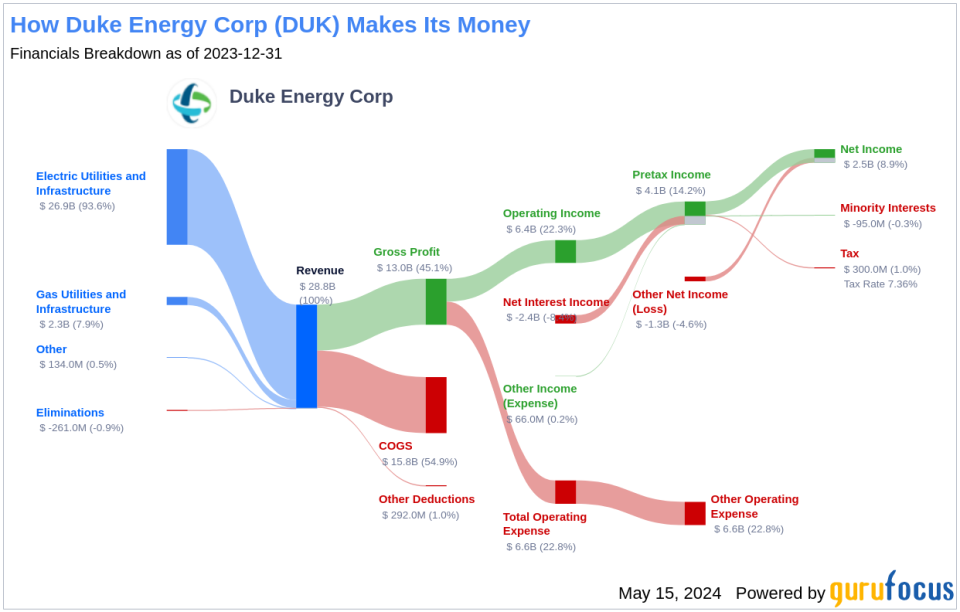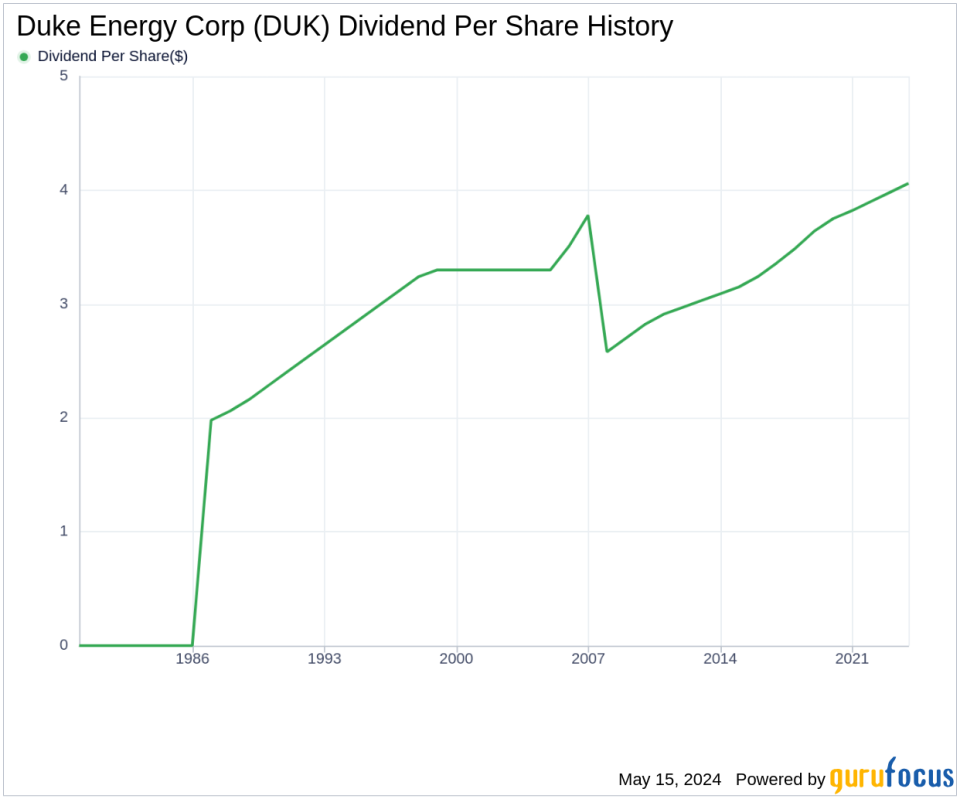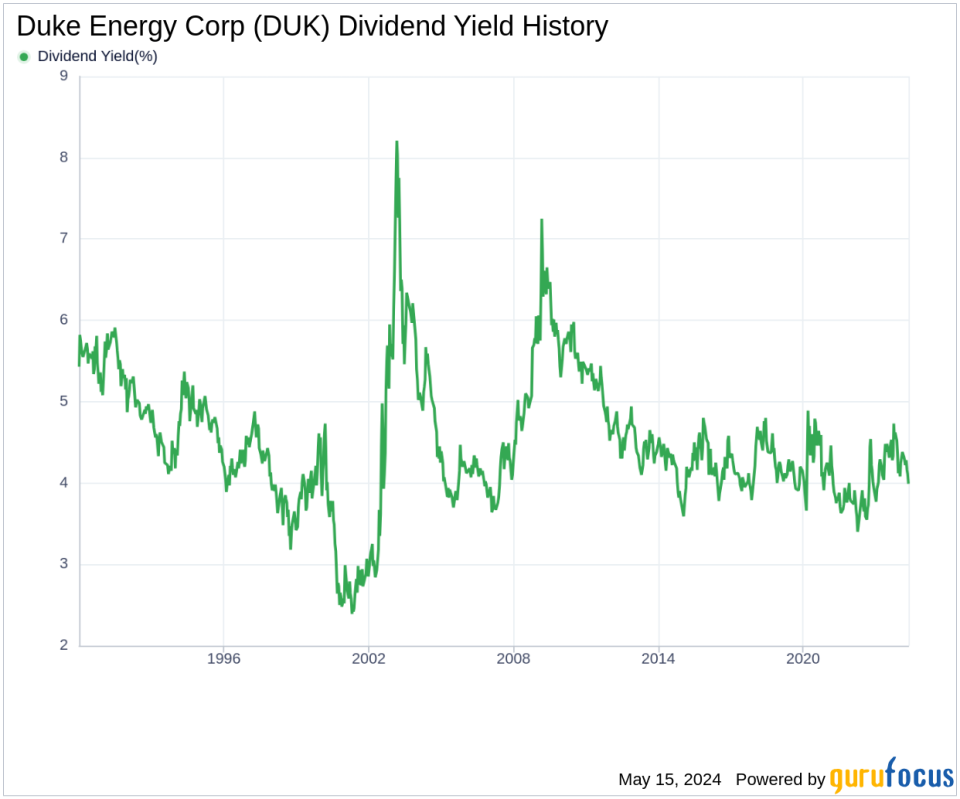Duke Energy Corp's Dividend Analysis
Exploring the Sustainability and Growth of Duke Energy's Dividends
Introduction to Duke Energy Corp's Upcoming Dividend
Duke Energy Corp (NYSE:DUK) recently announced a dividend of $1.03 per share, payable on 2024-06-17, with the ex-dividend date set for 2024-05-16. As investors look forward to this upcoming payment, the spotlight also shines on the company's dividend history, yield, and growth rates. Using the data from GuruFocus, let's look into Duke Energy Corp's dividend performance and assess its sustainability.
What Does Duke Energy Corp Do?
This Powerful Chart Made Peter Lynch 29% A Year For 13 Years
How to calculate the intrinsic value of a stock?
Duke Energy is one of the largest U.S. utilities, with regulated utilities in the Carolinas, Indiana, Florida, Ohio, and Kentucky that deliver electricity to 8.2 million customers. Its natural gas utilities serve more than 1.6 million customers.
A Glimpse at Duke Energy Corp's Dividend History
Duke Energy Corp has maintained a consistent dividend payment record since 1986. Dividends are currently distributed on a quarterly basis.
Duke Energy Corp has increased its dividend each year since 2007. The stock is thus listed as a dividend achiever, an honor that is given to companies that have increased their dividend each year for at least the past 17 years. Below is a chart showing annual Dividends Per Share for tracking historical trends.
Breaking Down Duke Energy Corp's Dividend Yield and Growth
As of today, Duke Energy Corp currently has a 12-month trailing dividend yield of 4.00% and a 12-month forward dividend yield of 4.01%. This suggests an expectation of increased dividend payments over the next 12 months.
Over the past three years, Duke Energy Corp's annual dividend growth rate was 2.10%. Extended to a five-year horizon, this rate increased to 2.20% per year. And over the past decade, Duke Energy Corp's annual dividends per share growth rate stands at 2.90%.
Based on Duke Energy Corp's dividend yield and five-year growth rate, the 5-year yield on cost of Duke Energy Corp stock as of today is approximately 4.46%.
The Sustainability Question: Payout Ratio and Profitability
To assess the sustainability of the dividend, one needs to evaluate the company's payout ratio. The dividend payout ratio provides insights into the portion of earnings the company distributes as dividends. As of 2024-03-31, Duke Energy Corp's dividend payout ratio is 0.76, suggesting that the company's dividend may not be sustainable.
Duke Energy Corp's profitability rank, offers an understanding of the company's earnings prowess relative to its peers. GuruFocus ranks Duke Energy Corp's profitability 8 out of 10 as of 2024-03-31, suggesting good profitability prospects. The company has reported positive net income for each year over the past decade, further solidifying its high profitability.
Growth Metrics: The Future Outlook
To ensure the sustainability of dividends, a company must have robust growth metrics. Duke Energy Corp's growth rank of 8 out of 10 suggests that the company's growth trajectory is good relative to its competitors.
Revenue is the lifeblood of any company, and Duke Energy Corp's revenue per share, combined with the 3-year revenue growth rate, indicates a strong revenue model. Duke Energy Corp's revenue has increased by approximately 6.00% per year on average, underperforming approximately 62.7% of global competitors.
The company's 3-year EPS growth rate showcases its capability to grow its earnings, a critical component for sustaining dividends in the long run. During the past three years, Duke Energy Corp's earnings increased by approximately 34.20% per year on average, underperforming approximately 17.48% of global competitors.
Lastly, the company's 5-year EBITDA growth rate of 6.20%, underperforms approximately 45.76% of global competitors.
Conclusion
Considering Duke Energy Corp's consistent dividend increase, robust profitability, and its strategic measures to sustain growth, the company presents a potentially stable dividend investment option. However, investors should be cautious about the high payout ratio, which could influence future dividend sustainability. For those interested in exploring further, GuruFocus Premium users can screen for high-dividend yield stocks using the High Dividend Yield Screener.
This article, generated by GuruFocus, is designed to provide general insights and is not tailored financial advice. Our commentary is rooted in historical data and analyst projections, utilizing an impartial methodology, and is not intended to serve as specific investment guidance. It does not formulate a recommendation to purchase or divest any stock and does not consider individual investment objectives or financial circumstances. Our objective is to deliver long-term, fundamental data-driven analysis. Be aware that our analysis might not incorporate the most recent, price-sensitive company announcements or qualitative information. GuruFocus holds no position in the stocks mentioned herein.
This article first appeared on GuruFocus.

 Yahoo Finance
Yahoo Finance 


